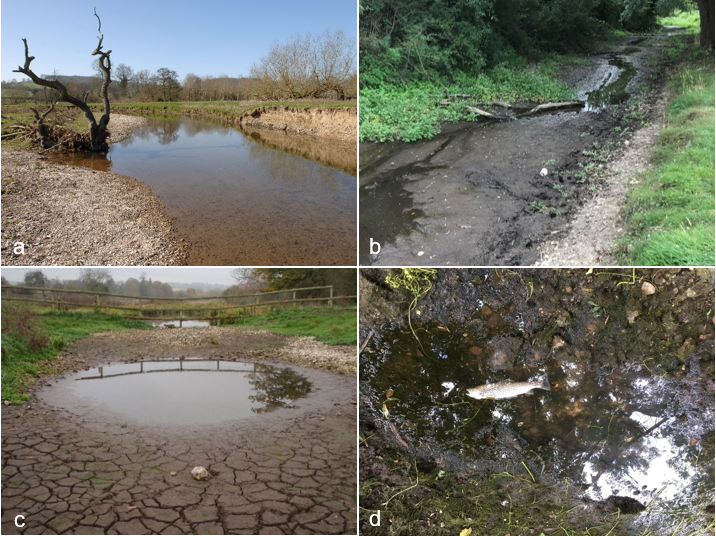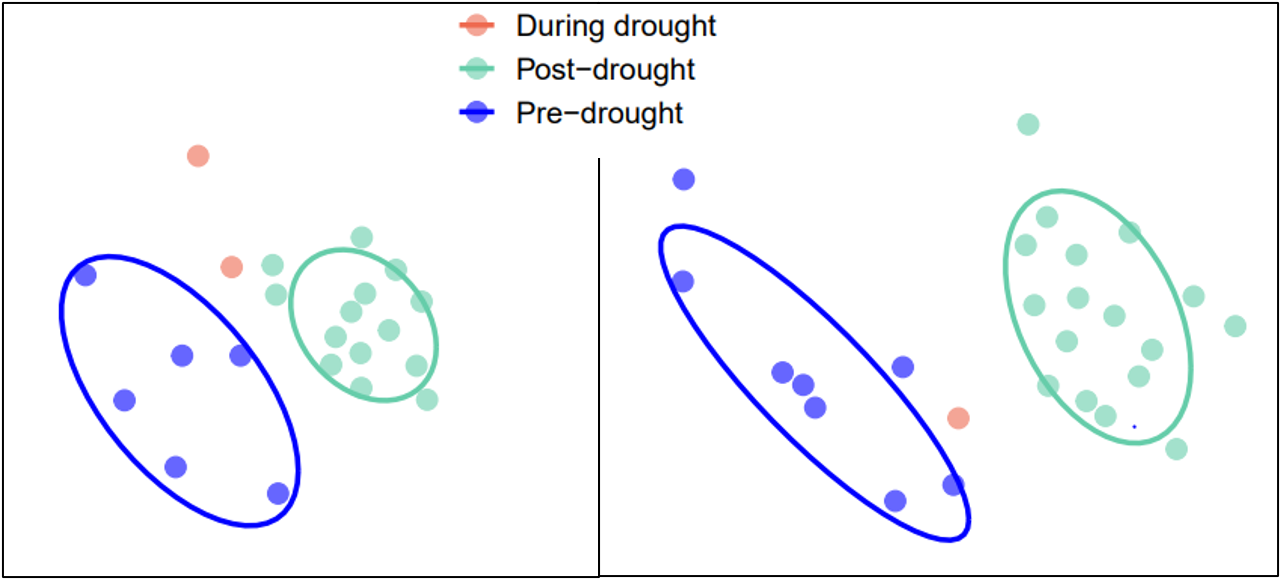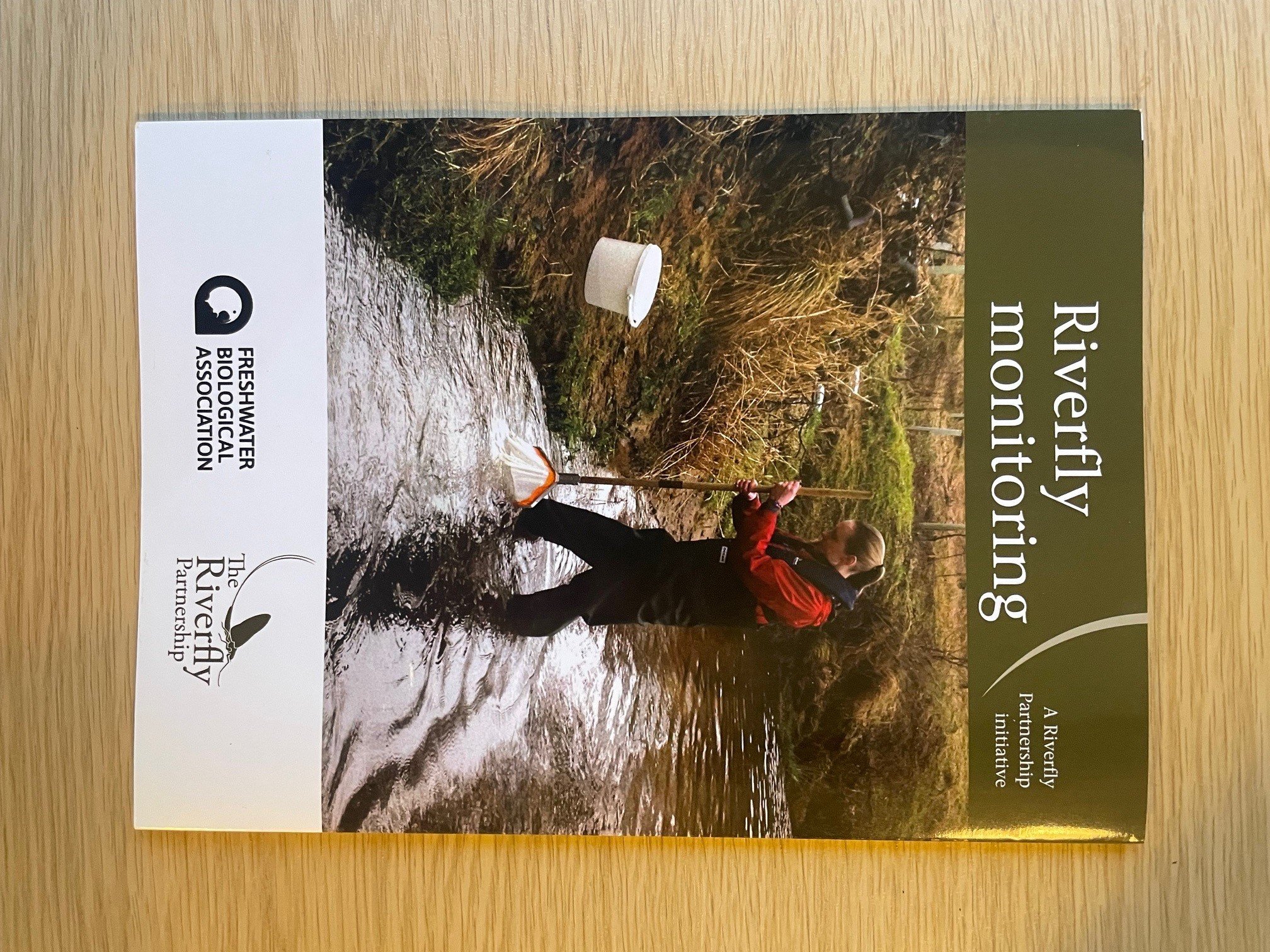What dries ahead? How future droughts could shape biodiversity in UK rivers
17 April, 2025
Rachel Stubbington (1)*, Romain Sarremejane (1) & Glenn Watts (2)
(1) Nottingham Trent University, Nottingham, UK, *rachel.stubbington@ntu.ac.uk; (2) UK Centre for Ecology & Hydrology, Wallingford, UK.
We are researchers interested in the ecological effects of drought and river drying on freshwater biodiversity. Here, we consider how future droughts could alter the communities in UK rivers, and if these events could drive ecosystem shifts to new stable states.
Edited by Rachel Stubbington, Nottingham Trent University
Rachel is both a Fellow of the Freshwater Biological Association and long-standing Editor of FBA articles. If you would like to submit an article for consideration for publication, please contact Rachel at: rachel.stubbington@ntu.ac.uk
Introduction
As we write this in April 2025, the exceptionally wet winter and spring of 2023-24 still lingers in the memory, but 2025’s dry spring weather has already led to unusually low river flows in many parts of the UK (NHMP 2025). The UK climate is becoming increasingly extreme (Hanlon et al. 2021), with frequent shifts from wet to dry conditions. It therefore seems timely to reflect on how droughts – prolonged periods of below-average water availability, which manifest in rivers as below-average flows (Figure 1) – are changing, and how these changes could alter biodiversity within UK rivers.
Figure 1. In-channel conditions during drought in UK rivers: (a) a ponded reach of the River Teme; (b) extreme low flows and (c) a pool on the River Misbourne; (d) a brown trout dies in a shrinking pool. Adapted from Stubbington et al. (2024). Photo credits: a–c, Environment Agency; d, N. Howard-Jones.
How might future droughts unfold in UK rivers?
An increase in the occurrence and severity of drought is suspected but has yet to be detected in UK rivers (Watts et al. 2015; Hannaford et al. 2024), perhaps due to changing rainfall patterns and our nation’s climatic variability. In contrast, there is greater confidence that short (<12-month) droughts will increase in intensity, duration, frequency and spatial extent in the coming decades, with predicted UK-wide reductions in streamflow being greatest in south-east England and least pronounced in north-west Scotland (Parry et al. 2024). However, whereas other global regions face multiyear megadroughts, there is little evidence that such events will become more common in the UK.
How droughts start and end may also change. In particular, the risk of ‘flash droughts’ – defined by their rapid onset and intensification – is increasing globally, including in temperate Europe, with Noguera et al. (2024) identifying a significant increase in such events in the UK in spring. Predicted periods of wetter weather and the increasing occurrence of heavy rainfall events (Watts et al. 2015) may mean that droughts also become more likely to end abruptly (Parry et al. 2016).
Future droughts will occur in a warming world, with greater evaporation exacerbating drought-driven low flows and river drying. Heatwaves – and thus concurrent drought–heatwave events – are also expected to become more common and severe, intensifying peaks in water temperatures as flows decline (Sutanto et al. 2020).
How might biodiversity respond to future droughts?
The effects of drought on biodiversity in UK rivers have been well-documented. Unsurprisingly, the diversity of aquatic communities from microbes to fishes declines during drought, with particular losses of sensitive taxa such as riverflies. But biodiversity soon bounces back, with most communities apparently recovering within months to, at most, three years. However, responses and recovery trajectories may differ during and after future droughts (Figure 2).
Figure 2. How biodiversity might respond to future droughts with altered characteristics in UK rivers. Adapted from Stubbington et al. (2024).
First, any increase in drought duration and intensity could reduce the extent and quality of refuges such as groundwater-fed springs, reducing the survival of even tolerant taxa. In non-perennial streams such as chalk winterbournes, such increases in drought severity could mean that seasonal dry phases start earlier, which could prevent specialist riverfly species – including some of conservation interest, such as the nationally rare winterbourne stonefly – from emerging as adults in time to escape desiccation (Macadam et al. 2021).
Second, increasing temperatures and heatwaves will also reduce refuge quality for fish and invertebrates, in part by reducing oxygen availability. In addition, any increase in the rate of drought onset could prevent organisms from moving into refuges as flows decline.
Moreover, if droughts become more frequent, an individual event will be more likely to occur while communities are still recovering from a previous drought, compounding and prolonging ecological impacts. In addition, if more droughts end with high flows, more organisms could be washed out of refuges, reducing local recovery. In non-perennial streams, short-duration flow resumptions triggered by downpours could reawaken dormant organisms, only for them to perish when the stream redries.
Could drought drive ecosystem shifts to new stable states? Yes!
Past UK-based studies have consistently documented rapid post-drought recovery of river communities. However, such conclusions are based largely on short-term (months to years) studies which lack pre-drought and/or post-drought data. Such studies typically document increases in then stabilization of metrics such as organism densities and species richness – but whether stabilized values represent pre-drought levels remains unknown. Moreover, conclusions based on univariate metrics such as species richness may overlook profound shifts in community composition.
Our ongoing research, based on 30-year time series documenting macroinvertebrate communities across England’s chalk rivers, suggests that such shifts do, in fact, occur – quite often (Figure 3). We have found that despite recovery of taxa richness, 17% of drought-impacted communities do not return to their previous taxonomic composition within 10 years of an individual drought ending. Moreover, 47% of communities experienced a drought-driven shift in composition at some point in the 30-year period.
Figure 3. Each circle represents a community, and circle positions reflect similarity among communities. Ellipses indicate the 95% confidence intervals used to define a community as recovered – or not.
What drives these shifts? Contrary to our expectations, shifting communities were characterized by taxa indicative of slower-flowing, poorer quality waters such as snails and leeches before drought, and taxa that prefer faster-flowing, better-oxygenated waters such as mayflies and caddisflies after drought. These surprising results suggest that drought can reset communities, allowing sensitive taxa to benefit from improvements to habitat quality.
An important research priority is to determine whether shifts in macroinvertebrate community composition reverberate throughout food webs and alter ecosystem functioning. Another concern is that the hotter, drier, faster-onset droughts of the future will push more taxa beyond their tolerance thresholds, allowing invasive and other competitive generalist species to thrive at the expense of overall biodiversity.
Implications for management
It is increasingly urgent that we act to enhance the drought resilience of freshwater communities. Although we cannot control climate-driven droughts, interactions with other stressors offer opportunities to mitigate their ecological impacts. In particular, our research has demonstrated that poor water quality and water abstraction can both exacerbate drought impacts (Sarremejane et al. 2024). Mitigating these stressors, focusing on strategic locations, could therefore complement restoration actions taken to promote a diverse range of high-quality refuge habitats that enhance the resilience of river communities to drought – whenever it next strikes.
Sources
This article is based on Stubbington et al. (2024, coauthored by Judy England and Paul J. Wood), and is informed by Sarremejane et al. (2024) and Sarremejane et al. (in prep.).
References
Hannaford, J., et al. 2024. Have river flow droughts become more severe? A review of the evidence from the UK–a data-rich temperate environment. Hydrology and Earth System Sciences Discussions. Preprint. https://doi.org/10.5194/hess-2024-293
Hanlon, H.M. et al. 2021. Future changes to high impact weather in the UK. Climatic Change 166: 50. https://doi.org/10.1007/s10584-021-03100-5
Macadam, C., Stubbington, R. & Wallace, I. 2021. The specialist insects that rely on the wet-dry habitats of temporary streams. FBA News: The Freshwater Biological Association Newsletter 81: 28–33. https://irep.ntu.ac.uk/id/eprint/44944/1/1498769_Stubbington.pdf
NHMP (National Hydrological Monitoring Programme) 2025. Hydrological Summary for the United Kingdom: February 2025. UK Centre for Ecology & Hydrology. https://nrfa.ceh.ac.uk/sites/default/files/2025-03/HS_202502%20v2_0.pdf
Noguera, I., Hannaford, J. & Tanguy, M. 2025. Distribution, trends, and drivers of flash droughts in the United Kingdom. Hydrology and Earth System Sciences 29: 1295–1317. https://doi.org/10.5194/hess-29-1295-2025
Parry, S. et al. 2016. A systematic assessment of drought termination in the United Kingdom. Hydrology and Earth System Sciences20: 4265–4281. https://doi.org/10.5194/hess-20-4265-2016
Parry, S. et al. 2024. Divergent future drought projections in UK river flows and groundwater levels. Hydrology and Earth System Sciences Discussions 28: 417–440. https://doi.org/10.5194/hess-28-417-2024
Sarremejane, R. et al. 2024. Human impacts mediate freshwater invertebrate community responses to and recovery from drought. Journal of Applied Ecology 61: 2616–2627. https://doi.org/10.1111/1365-2664.14771
Sarremejane, R. et al. In prep.. Drought and human pressures interact to drive persistent changes in freshwater invertebrate communities.
Stubbington, R. et al. 2024. The effects of drought on biodiversity in UK river ecosystems: Drying rivers in a wet country. Wiley Interdisciplinary Reviews: Water 11: e1745. https://doi.org/10.1002/wat2.1745
Sutanto, S.J. et al. 2020. Heatwaves, droughts, and fires: Exploring compound and cascading dry hazards at the pan-European scale. Environment International 134: 105276. https://doi.org/10.1016/j.envint.2019.105276
Watts, G. et al. 2015. Climate change and water in the UK–past changes and future prospects. Progress in Physical Geography 39: 6–28. https://doi.org/10.1177/0309133314542957
Further reading
Stubbington, R. 2023. The ecological effects of drought on England’s rivers. In: Review of the research and scientific understanding of drought. Environment Agency. Available here.
Further FBA reading
The Freshwater Biological Association publishes a wide range of books and offers a number of courses throughout the year. Check out our shop here.
Get involved
Our scientific research builds a community of action, bringing people and organisations together to deliver the urgent action needed to protect freshwaters. Join us in protecting freshwater environments now and for the future.












